Shop Solver
For instructions on how to use the Define Commands, please click here.
Define Vector
A vector is a
line segment that has both magnitude (length) and direction. It is has a
starting point known as the foot and an ending point known as the head.
The direction of the vector extends from the foot to the head.
The magnitude of the vector is the distance between the foot and the
head and is always positive. All
vectors with the same magnitude and direction are treated as equivalent no
matter where their feet and heads are defined. When not specified
in a definition the foot defaults to the origin. In many cases a vector
definition may substitute a given vector with a point definition.
If a point is specified then it is assumed to be a vector whose
foot is the origin. A vector may be defined by any of the
following:
Rectangular Coordinates
2 End Points (X1, Y1, Z1, X2, Y2,Z2)
2 End Points (Point1, Point2)
Perpendicular to a Plane
Scalar Times a Vector
Scalar Times a Point
Cross Product of 2 Vectors or Points
Normalizing a Vector by Components
Normalizing a Vector by a Vector
Normalizing a Vector by a Point
Length (Magnitude) and an Angle in a Plane
Parallel to the Intersection of 2 Planes
Addition or Subtraction of 2 Vectors or Points
In the XY Plane Having an Angle with a Line
Rectangular Coordinates
VECTOR/dx,dy,dz
The vector is defined by the components dx, dy, dz. The components are the distances along the X-, Y- and Z-axes respectively. This definition is equivalent to the 2 End Points definitions below when X1=0, Y1=0 and Z1=0, or when the X, Y and Z distances from Point2 to Point1 is equal to dx, dy and dz. See figure Vector.1 below.
2 End Points (X1, Y1, Z1, X2, Y2,Z2)
2 End Points (Point1, Point2)
VECTOR/x1,y1,z1,x2,y2,z2
VECTOR/point1,point2
The vector is defined by coordinates of its foot and head. In the former the foot is at x1, y1, z1 and the head is at x2, y2, z2. In the latter the foot is at point1 and the head is at point2.
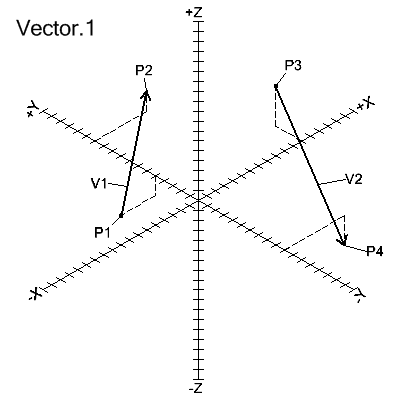
V1=VECTOR/10,7,4
V2=VECTOR/-5,-13,-7
or
V1=VECTOR/-4,5,-2,6,12,2
V2=VECTOR/12,3,4,7,-10,-3
or
V1=VECTOR/P1,P2
V2=VECTOR/P3,P4
Perpendicular to a Plane
VECTOR/PERPTO,plane,modifier
modifier: NEGX | NEGY | NEGZ | POSX | POSY | POSZ
The vector is defined as perpendicular to plane.
The modifier indicates the direction of the vector. NEGX
indicates that the vector points in the negative X direction, POSZ in
the positive Z direction, etc.
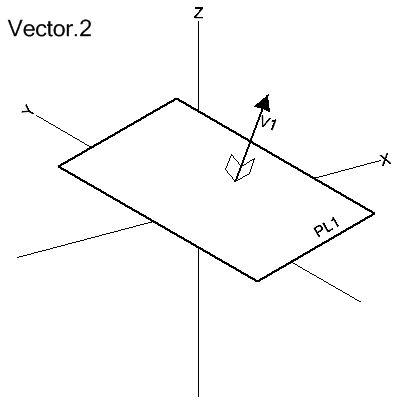
V1=VECTOR/PERPTO,PL1,POSZ
Scalar Times a Vector
Scalar Times a Point
VECTOR/scalar,TIMES,vector
VECTOR/scalar,TIMES,point
The defined vector is formed by multiplying each component of vector by scalar. If point is specified then the X, Y and Z coordinates of point are multiplied by scalar.
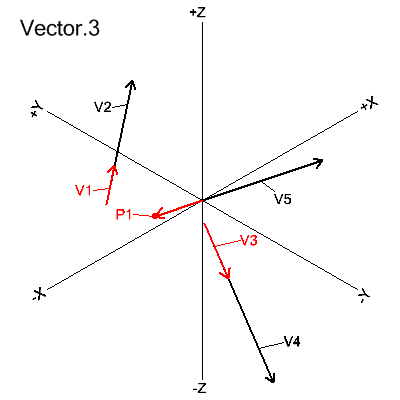
V2=VECTOR/3.25,TIMES,V1
V4=VECTOR/2.4,TIMES,V3
V5=VECTOR/-2.6,TIMES,P1
Cross Product of 2 Vectors or Points
VECTOR/vector1 | point1, CROSS, vector2 | point2
The vector is defined as the cross product of vector1 (or point1) with vector2 (or point2).
If points are specified then they are assumed to be vectors whose
feet are the origin.
The
cross product of 2 vectors is a third vector that is perpendicular to
the plane formed by the 2 given vectors. The length of the
resultant vector is the length of vector1 times the length of vector2
times the sine of the angle formed between the 2 given vectors.
Its direction is determined according to the right-hand rule.
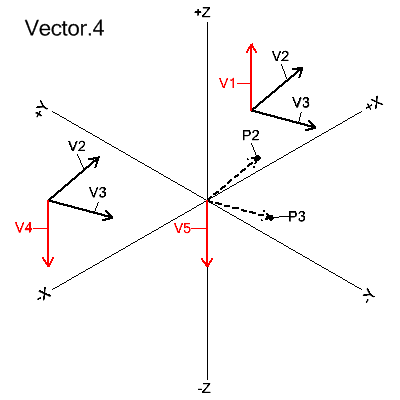
V1=VECTOR/V3,CROSS,V2
V4=VECTOR/V2,CROSS,V3
V5=VECTOR/P2,CROSS,P3
Normalizing a Vector by Components
Normalizing a Vector by a Vector
Normalizing a Vector by a Point
VECTOR/UNIT,x,y,z
VECTOR/UNIT,vector
VECTOR/UNIT,point
The
vector is defined by normalizing the given vector. The given
vector may be specified by the coordinates of its head, by another
vector, or a point. If the given vector is specified by
coordinates then its foot is assumed to be the origin. It the
given vector is specified by a point then the point is assumed to be a
vector with its foot at the origin.
A normalized or unit vector is one that has the same direction as the given vector but with a length of 1.
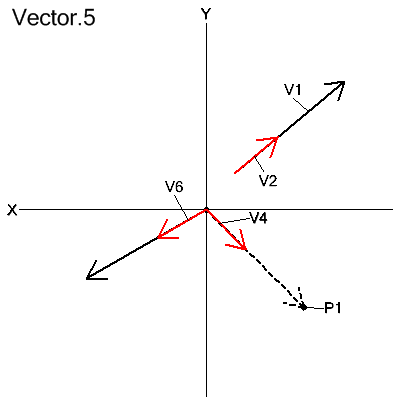
V2=VECTOR/UNIT,V1
V4=VECTOR/UNIT,P1
V6=VECTOR/UNIT,-10.4,-6.2,0
Length (Magnitude) and an Angle in a Plane
VECTOR/LENGTH,len,ATANGL,theta,modifier
modifier: XYPLAN | YZPLAN | ZXPLAN
The vector is defined as having length len and at angle theta
in the given plane. The angle is measured from the positive axis
belonging to the first letter of the plane modifier. Note that
rotation occurs around the axis component missing from
the plane. For example, XYPLAN is missing the Z-component so
rotation occurs around the Z-axis.
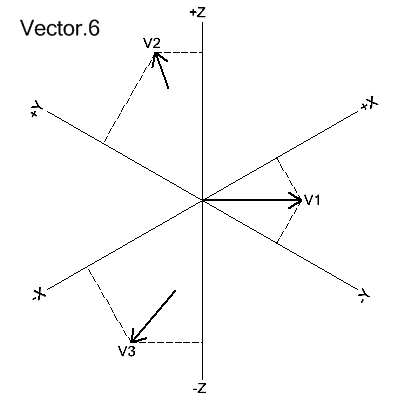
V1=VECTOR/LENGTH,10,ATANGL,315,XYPLAN
V2=VECTOR/LENGTH,4,ATANGL,60,YZPLAN
V3=VECTOR/LENGTH,7,ATANGL,150,ZXPLAN
or
V1=VECTOR/LENGTH,10,ATANGL,-45,XYPLAN
V2=VECTOR/LENGTH,4,ATANGL,-300,YZPLAN
V3=VECTOR/LENGTH,7,ATANGL,-210,ZXPLAN
Parallel to the Intersection of 2 Planes
VECTOR/PARLEL,INTOF,plane1,plane2,modifier
modifier: NEGX | NEGY | NEGZ | POSX | POSY | POSZ
The vector is defined as parallel to the line of intersection of plane1 with plane2. Its direction is determined by modifier according to the positive or negative axis component of modifier when applied to the X, Y or Z coordinates of the vector's head. For example, POSZ specifies a positive Z-component.
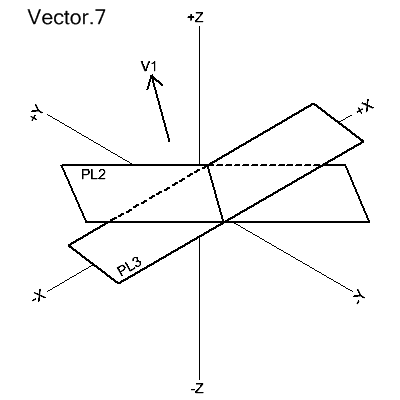
V1=VECTOR/PARLEL,INTOF,PL2,PL3,POSY
Addition or Subtraction of 2 Vectors or Points
VECTOR/vector1 | point1, operator, vector2 | point2
operator: PLUS | MINUS
The vector is defined by the addition or subtraction of vector1 (or point1) with vector2 (or point2). If points are specified then they are assumed to be vectors whose feet are the origin.
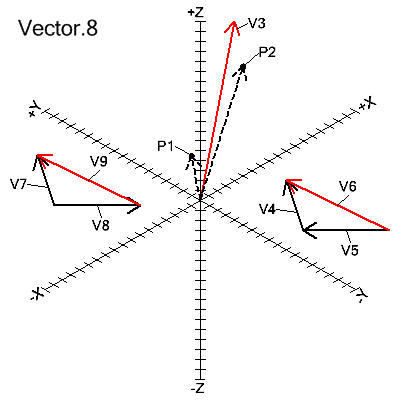
P1=POINT/1.0,2.0,3.0
P2=POINT/10.0,5.0,6.0
V3=VECTOR/P1,PLUS,P2
V4=VECTOR/3.0,-9.0,0,7.0,-3.0,0
V5=VECTOR/8.0,-14.0,0,3.0,-9.0,0
V6=VECTOR/V4,PLUS,V5
V7=VECTOR/-9.0,8.0,0,-5.0,14.0,0
V8=VECTOR/-9.0,8.0,0,-4.0,3.0,0
V9=VECTOR/V7,MINUS,V8
In the XY Plane Having an Angle with a Line
VECTOR/ATANGL,theta,line,modifier
modifier: POSX | XLARGE | POSY | YLARGE | NEGX | XSMALL | NEGY | YSMALL
The vector is defined as a unit vector at angle theta to line.
The modifier specifies which of the 2 possible vectors is
required. POSX and XLARGE have the same meaning and select the
vector whose head has a positive X-component. The other pairs of
modifiers apply similar logic.

V1=VECTOR/ATANGL,25.0,L1,POSX
V2=VECTOR/ATANGL,-60.0,L1,POSX
V3=VECTOR/ATANGL,-15.0,L1,XSMALL








